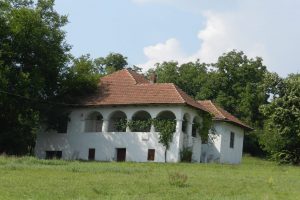

The building was built, according to tradition by Ghiţă Cuţui, pandour captain and his son, Constantin, around 1815.
The place where the forteress was built is tied to a tragic story in the captain’s life. A group of Turkish people from the Ada-Kaleh Island kidnapped Ghiţă Cuţui’s wife. For the ransom, the pandour sold part of his land, building afterwards the Cuţui fortress. Constantin Cuţui built the Saints Emperors Constantin and Elena church in 1836, the painting being completed in 1840 at the expense of his son, Mihalache. The fortress house was devastated by the German occupation troops, in 1916 and after 1930 Constantin I. Cuţui and Ioana Cuţui attempted a restoration, with no success. After 1954 the Cuţui fortress remained in ruin until 1963, when architect Iancu Atanasescu creates the restoration project and from 1965 the project is taken over by architect Rodica Manciulescu who continues the works until their completion, in 1968. Until 1990, a ethnographic museum functioned here.
The brick construction is rectangular on two levels. The basement, on the ground floor has very thick walls that support a cylindrical arch sustained on five double arches. The higher level is reached through an oak stairwell, the walls of the stairwell being penetrated by ramparts, through which the access to the fortress was protected. The first floor, where there is also the porch, has many rooms whose organization has suffered a few changes through time. The ceilings are of plastered timbers and the floor of wide oak boards. The verandah has trilobite arches, six on the main side and one at the free side towards the north-west. On the outside of the building, the facades are decorated with small panels place irregularly from the arches and large panels on the rest of the floor surface.
The fortresses are fortified houses whose name comes from the Turkish word “zkule” that means tower. They were built by landowners on their estates in Oltenia to protect themselves against the Turkish gaggles (adalii, cirjalii, pazvangii) come from the Danube tribes. Their spread was wide across all of Oltenia and west Wallachia.
Close to the fortress there is the Saints Emperors Constantin and Elena church also known as Cuțui church which was built in 1836 by Constantin Cuţui, son of pandour captain Ghiţă Cuţui. Since the founder died in the meantime, the church was painted at the expense of his son Mihalache in 1840. Afterwards the church had a few transformations, being entirely paved with cement and having a new door. The brick church is in the shape of a ship with a verandah, a narthex, a nave and an altar with two steeples.

